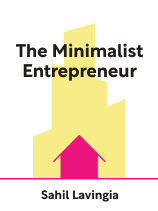

This article is an excerpt from the Shortform book guide to "The Minimalist Entrepreneur" by Sahil Lavingia. Shortform has the world's best summaries and analyses of books you should be reading.
Like this article? Sign up for a free trial here.
What is a niche? Why is it important to find your niche in your business?
A niche is something your business will specialize in. In The Minimalist Entrepreneur, Sahil Lavingia explains that your niche should be a solution to a problem that’s already present in certain communities.
Learn how to find your niche so you can help others.
Finding Your Niche
Identifying your business starts with learning how to find your niche by asking what problem you want to solve, and for what community of people. Lavingia says this often starts with trying to solve a problem you have. So, for example, he got ideas for new apps by noticing things he wished there was an app for. His current business, Gumroad, was born similarly. He needed a platform for selling icons he had designed, so he created it.
Unlike other business models, in Lavingia’s minimalist method you are not “creating” a problem people didn’t know they had and then selling them the solution (for example, a beauty product designed to hide your pores when you never thought about your pores before). You’re identifying a problem that already exists within a community you care about, and that you want to solve for those people.
(Shortform note: Think outside the box when you’re considering what problem to solve, and don’t be afraid to have a narrow focus. Check out this HGTV list of 35 problem-solving products to get an idea of how diverse the possibilities are. They range from a mini spatula made for small jars to a Bluetooth sleep mask. If you’re thinking of making a physical product to sell, you’ll want to first create a prototype and test the product yourself. From there, revise if necessary until the product does exactly what it’s meant to do.)
So, to start getting ideas, you need to first identify your potential target communities. Lavingia says many businesses fail because they don’t start with a target community in mind.
To narrow down who your customer is and what problem you are trying to solve for them, look in your own communities. Lavingia says this will ensure that you’ll have a business you’ll be passionate about. Think about any hobbies, interests, or social groups you belong to, online or in your local community, and write down the answers to these questions:
- What kinds of people do you enjoy spending time with, or regularly interact with due to a common interest?
- What kinds of people like to hear what you have to say?
- Where can you find these people?
Once you have solid answers, find as many relevant groups as you can (online and in person), and join them, in order to get to know people and the subject better. Lavingia advises looking for Facebook groups, Reddit communities, and related Twitter and Instagram hashtags to find people involved in your target groups and where they’re gathering.
Lavingia says you shouldn’t think of this as “networking,” but as simply joining communities. With networking, you’d be starting from scratch trying to form connections with people who might be able to help you. Whereas within your communities you already have a natural connection, and your relationships are reciprocal.
Establish Yourself
Once you’ve joined all the groups you can find, you’ll want to start building strong relationships within these communities. In most social media communities, Lavingia explains, the vast majority of members are just passive observers, or “lurkers.” A smaller group is active contributors, meaning they regularly participate in discussions. And an even smaller group are creators, meaning they actually create and post content for others to comment on. You’ll likely find a similar structure with in-person community groups.
Lavingia says you should gradually work your way up to being a recognized expert in your communities, in this way:
- Lurk for a while. Read or observe to learn everything you can about the group and the topics being discussed.
- Start to contribute. When you’ve familiarized yourself with the group and content, start engaging in discussions. As you do this more frequently, people in your communities will eventually start to recognize you. If you consistently keep learning, you’ll increasingly have valuable contributions.
- Start to create. When you’re comfortable and confident with the subject matter, start to create and teach. Whatever you’ve learned, there will be others who want to learn it. Create your own posts, for example, and others will begin to see you as an established expert in the community.
- Discover what excites you. As you get more involved with these groups, evaluate where you really feel excited, and determine whether a particular community or niche within that community is aligning with your passion.
- Listen to people. As you have conversations with people, really listen to them. They’ll eventually tell you what problem needs solving. Your business will be solving it for them.
Lavingia says you can try this method with a few different communities/interests until you find the right community with the right problem. Then it will be time to pin down the solution to the problem.
Identifying Target Communities and Their Problems
Lavingia’s idea of identifying target communities is broader than the traditional approach to marketing demographics. Traditionally, market demographics tend to be based on age, gender, race, or income-level categories. In The $100 Startup, Chris Guillebeau echoes Lavingia’s advice to focus more on demographics based on common interests, beliefs, values, and skills. By focusing on this kind of demographic, your product or service will be catered more specifically to the wants and desires of the consumer. Guillebeau offers two strategies for targeting a specific audience and identifying your product or service:
- Look at popular fads and trends in your demographic groups and identify something that’s popular right now. Figure out how you can offer a product or service related to that. For example, you may notice a growing number of people discussing and adopting vegan diets in a fitness community. Could you offer coaching, an app, or a course to help people transition to a vegan lifestyle?
- Conduct surveys and interviews with people in your focus demographic to ask them what they need. In these questionnaires, you might propose some potential ideas for products, and ask respondents to rank or rate them in terms of how much they would want that.
Create High-Quality Content
In recent years, a growing number of people have found their niche “content creators.” Whether you want this to be your business or not, it might help to learn a little bit about what a content creator does, so you can leverage that knowledge as you become a creator in your online communities.
In other words, if you’re going to start posting content in groups and you want to be viewed as a reliable and trustworthy source, you should put some thought into what (and how) you post. Some tips for creating meaningful social media content are:
- Know your stuff: Focus on writing and posting about topics you’re well-educated in, and always refer to reliable high-quality sources. Be sure to research any information you link to, to confirm its credibility.
- Pay attention to detail: Any content you post online should be well-written and easy to read. Be sure to proofread for errors before you post. If your posts are riddled with typos, lacking in punctuation, or poorly articulated, you’ll lose credibility.
- Have a repository for your content: Maintain a website or a social media page where everything you create is accessible. So, when you’re posting in one of your community groups, you can link to your website or Facebook page where readers can find more of your content. You may also consider linking to your LinkedIn page, and be sure you keep that up to date, as this will further create the impression that you’re an “expert” in your field.

———End of Preview———
Like what you just read? Read the rest of the world's best book summary and analysis of Sahil Lavingia's "The Minimalist Entrepreneur" at Shortform.
Here's what you'll find in our full The Minimalist Entrepreneur summary:
- Detailed advice for starting your own business without venture capital
- How to run your business sustainably and contribute to the world
- Why you don’t need to spend any money on marketing






